Mass-Storage Structure¶
约 1462 个字 13 张图片 预计阅读时间 5 分钟
Overview¶
Magnetic disks provide bulk of secondary storage of computer system.
hard disk is most popular.
Disk Structure¶

可见 DB 笔记
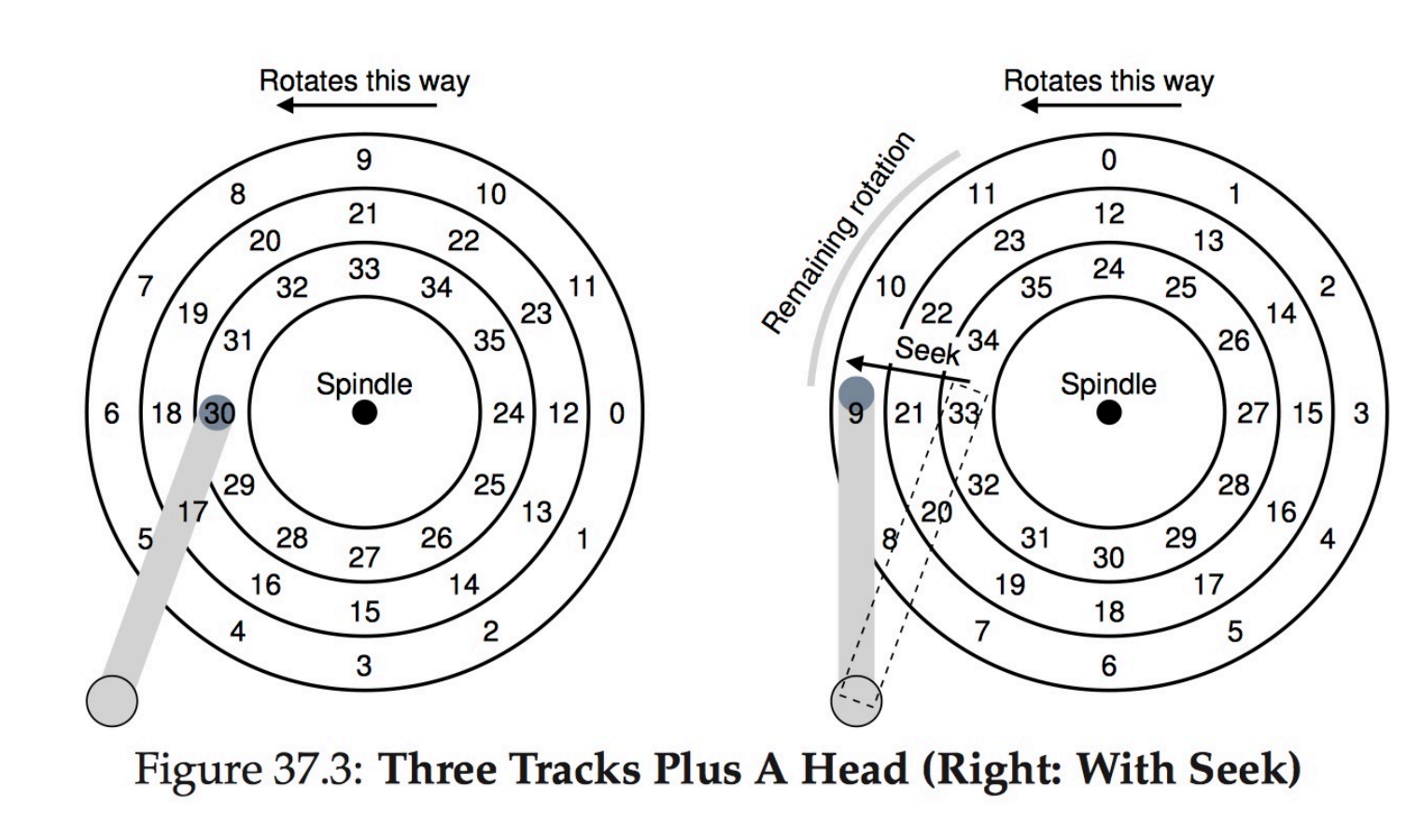
-
Positioning time(random-access time) is time to move disk arm to desired sector
- seek time: move disk to the target cylinder
- rotational latency: for the target sector to rotate under the disk head
-
Performance
- transfer rate: theoretical 6 Gb/sec; effective (real) about 1Gb/sec
- seek time from 3ms to 12ms (9ms common for desktop drives)
- latency based on spindle speed: 1/rpm * 60
- average latency = ½ latency
Example
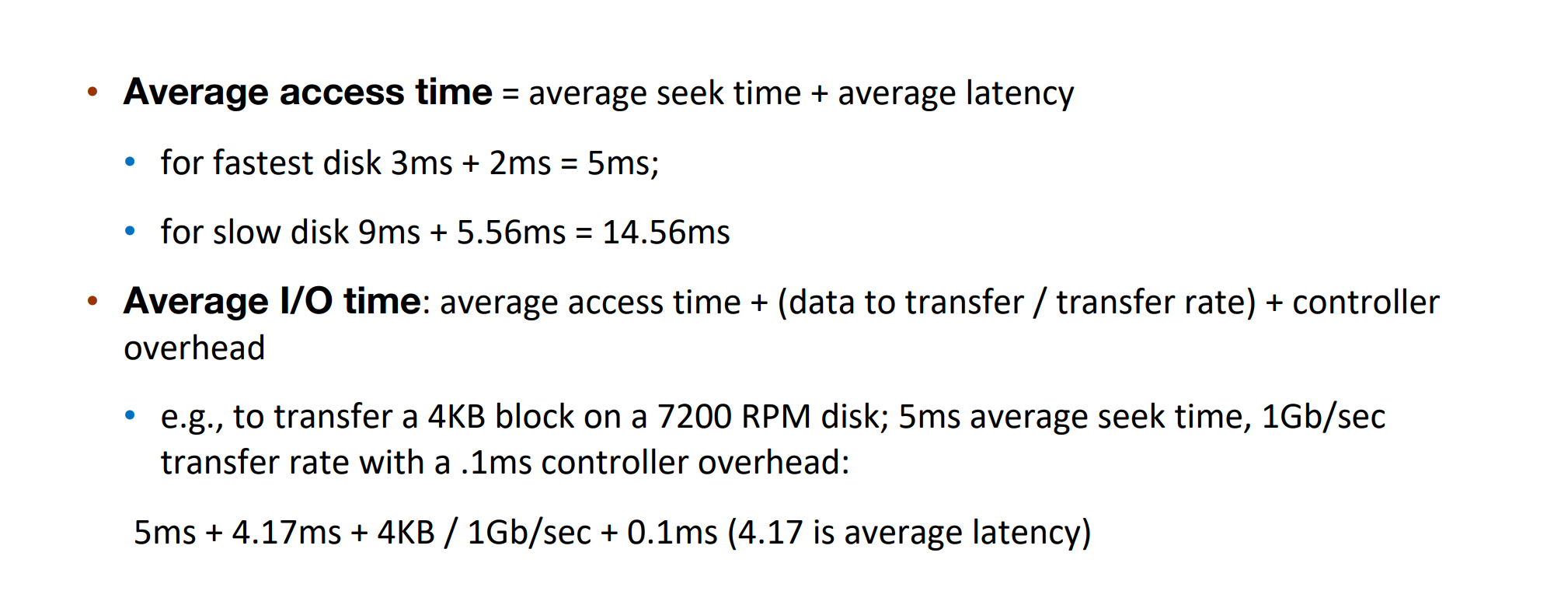
主要慢在 seek 和 rotation 部分。
Disk Scheduling¶
磁盘也需要调度,以减少 access time。
以前 OS 会负责调度,现在由 firmware 负责(disk controller
There are many disk scheduling algorithms
- FCFS
- SSTF
- SCAN, C-SCAN
- LOOK, C-LOOK
We use a request queue of cylinders “98, 183, 37, 122, 14, 124, 65, 67” ([0, 199]), and initial head position 53 as the example.
注意这里说的是 cyclinder 柱面(包含若干等距离的 track),只有不在同一柱面的才需要 seek,同一柱面不同 track 不需要动磁头,不同 sector 就靠转动。
FCFS¶
First-come first-served, simplest scheduling algorithm.
Example
Total head movements of 640 cylinders
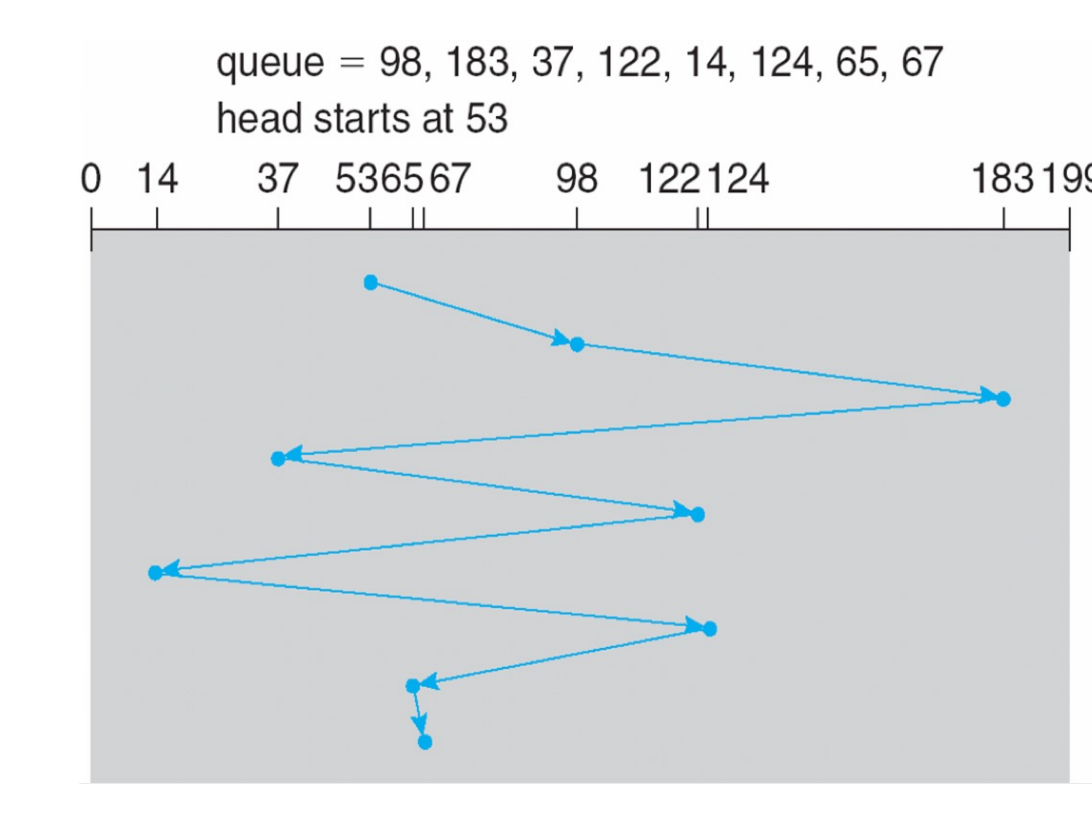
- Advantage:
- Every request gets a fair chance
- No indefinite postponement
- Disadvantages:
- Does not try to optimize seek time
- May not provide the best possible service
SSTF¶
shortest seek time first.
类似 SJF,选择离现在 head position 最近的 request。但是 SSTF 不一定最好。可能发生 starvation。
Example

-
Advantages:
- Average Response Time decreases
- Throughput increases
-
Disadvantages
- Overhead to calculate seek time in advance
- Starvation may exist
- High variance : favors only some requests
SCAN¶
也叫 elevator 电梯算法,先扫到一头,再往另一头扫,如果遇到 request 就读取。
Example
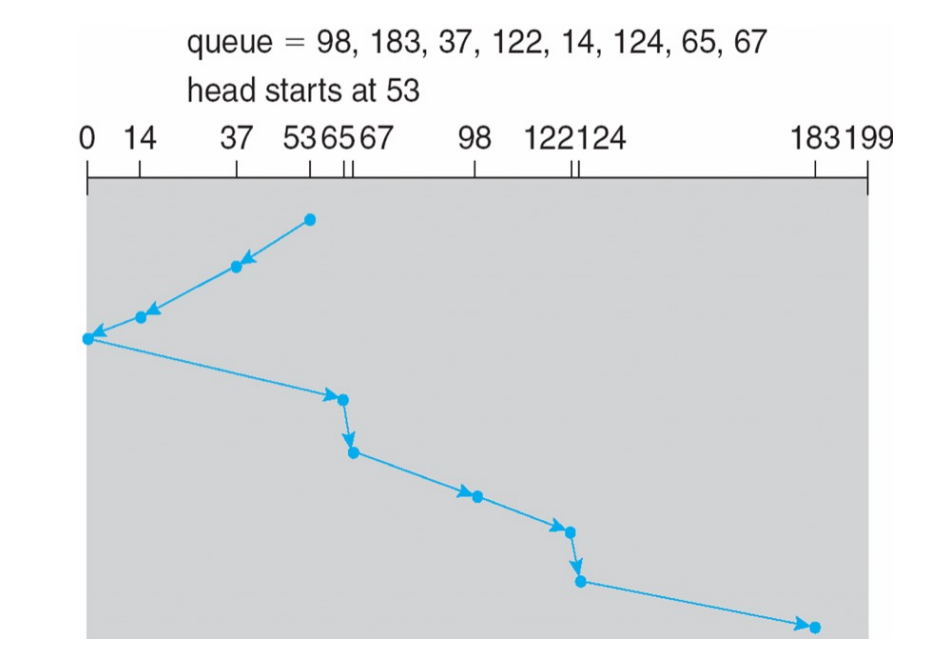
- Advantages:
- Average Response Time
- High Throughput
- Low variance of response time
- Disadvantages:
-
Long waiting time for requests for locations just visited by disk arm
如果刚好错过电梯,就要等电梯触底再上来,等待时间很长。
-
C-SCAN(Circular-SCAN) is designed to provides a more uniform wait time. 只做单向的扫,到达一端时立刻回到开头,随后从底往上扫,这样最多只用等待一圈。
LOOK¶
在 SCAN / C-SCAN 的基础上,只走到一端最后一个任务(look 是否有请求)而不走到 disk 的头。
LOOK is a version of SCAN, C-LOOK is a version of C-SCAN.
Example

- Advantage:
- Prevents the extra delay which occurred due to unnecessary traversal to the end of the disk.
Selecting Disk-Scheduling Algorithm
依赖于请求的模式,而请求本身又依赖于文件分配策略。文件系统如果注重空间局部性,能够提供很好的表现提升。
如果 I/O 比较少,FCFS 和 SSTF 即可。如果是大型的服务器或者数据库,一般使用 C-LOOK。如果是 SSD(不用 seek
Nonvolatile Memory Devices¶
If disk-drive like, then called solid-state disks (SSDs).
固态硬盘
Can be more reliable than HDDs,
与磁盘相比,寿命短,容量小,速度快(Bus 慢,需要直接连到 PCIE 上
-
Read and written in “page” increments (think sector) but can’t overwrite in place.
- Must first be erased, and erases happen in larger “block”
- Assume block size: 64k
-
Can only be erased a limited number of times before worn out – ~ 100,000
寿命短,里面是用门电路实现。充放电(擦写)门会被击穿,就无法区分 0/1 了。
-
Life span measured in drive writes per day(DWPD)
Each cell has lifespan, so need to write equally to all cells.
Magnetic Tape¶
磁带,容量很大,但是很慢。因为需要倒带,一般都做顺序访问而不是随机访问。现在主要用来做备份。
data stored on the tape are relatively permanent.
Disk Management¶
使用这些介质(磁盘、固态硬盘、磁带)的时候,需要先格式化。
Physical formatting: divide disk into sectors for controller to read/write.
即把介质上分好不同的部分。
- partition disk into groups of cylinders, each treated as a logical disk.
- logical formatting partitions to make a file system on it.
Disk Attachment¶
-
host-attached storage
-
hard disk, RAID arrays, CD, DVD, tape...
可以插到 I/O Bus 上。

-
-
network-attached storage
- storage area network
RAID¶
Disks are unreliable, slow, but cheap. Simple idea: let’s use redundancy to improve reliability and speed.
HDDs 越来越小和便宜,因此如果一个系统可以拥有大量磁盘,那么就能改善数据的读写速率(因为可以并行)和可靠性(使用冗余来降低出现错误的期望
-
Data Mirroring
- Keep the same data on multiple disks
-
Data Striping
- Keep data split across multiple disks to allow parallel reads
-
Error-Code Correcting (ECC) - Parity Bits
- Keep information from which to reconstruct lost bits due to a drive failing
这里 RAID 0 的技术主要是 Striping,RAID 1 的技术主要是 Mirroring,因此我们有时会说 5+1,5+0,表示几个技术结合。
RAID 0¶
没有 redundancy,什么也不做,把数据分散在不同的磁盘。
Improves performance, but not reliability.
Example
- Fixed strip size
- 5 files of various sizes
- 4 disks
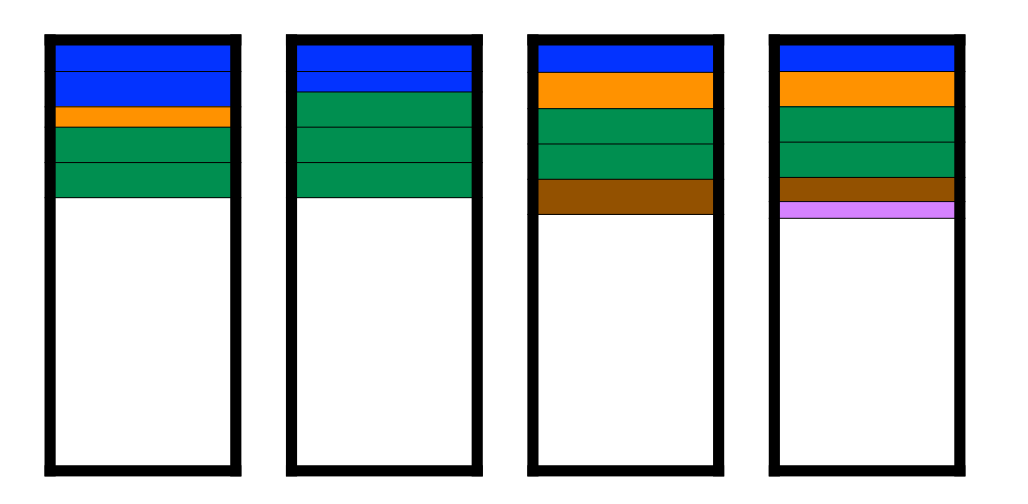
RAID 1¶
也被称为 mirroring,存在两个磁盘,一个是主磁盘,一个是备份磁盘。主磁盘写入数据后,备份磁盘也写入相同的数据。
Example
- 5 files of various sizes
- 4 disks
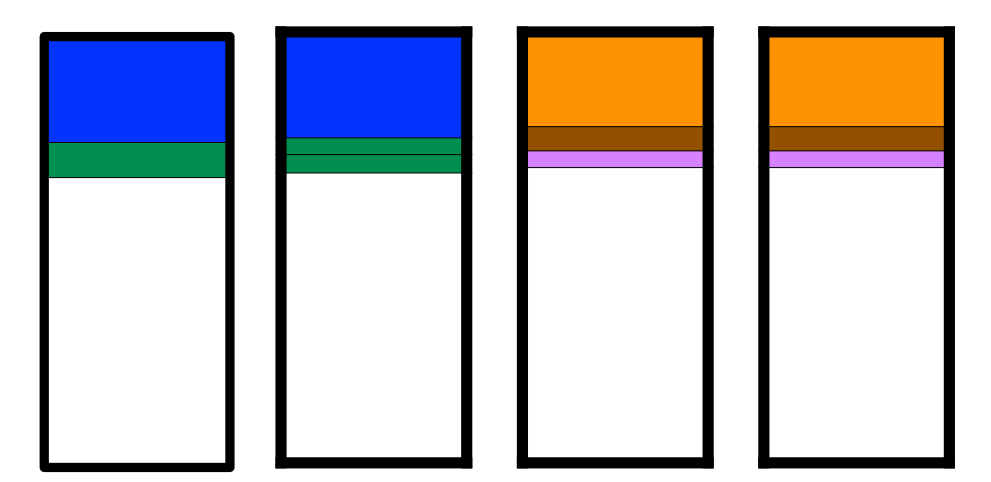
Reliability is ensured unless you have (extremely unlikely) simultaneous failures, performance can be boosted by reading from the disk with the fastest seek time.
但是浪费了一半的磁盘。
RAID 2¶
stripes data at the bit-level; uses Hamming code for error correction (not used).
没有被实际应用,因为粒度太小,现在无法单独读出来一个比特,至少读出一个字节。

RAID 3¶
Data is striped across multiple disks, with one dedicated parity disk that stores the parity information for all the data disks.
纠错码就在一个磁盘里。

RAID 4,5,6¶
-
RAID 4: Basically like RAID 3, but interleaving it with strips (blocks)
用块来做 strip,纠错码单独存在一个盘里。这个纠错盘一直会被读写,很有可能先损坏。
-
RAID 5: Like RAID 4, but parity is spread all over the disks as opposed to having just one parity disk.
parity bit 被分散地存到了不同的磁盘里。相比于 RAID 4,每个盘的读写比较均衡。
-
RAID 6: extends RAID 5 by adding an additional parity block.
又加了一个 parity bit,也是分散存储。

RAID and File Systems¶
RAID 只检测磁盘失效,并不知道对应的是哪个文件失效。
ZFS adds checksums to all FS data and metadata.
这样可以检验磁盘是否写错。
Takeaway¶
Takeaway
- Disk structure
- Disk scheduling
- FCFS, SSTF, SCAN, C-SCAN, LOOK, C-LOOK
- RAID 0-6